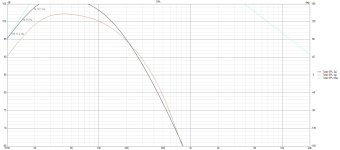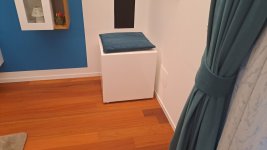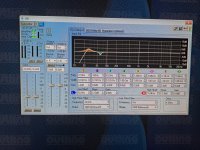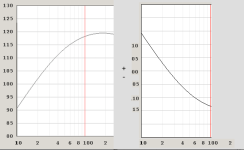I have two subwoofers using B&C 18TBX100 drivers currently installed in my HT system. Recently, it was pointed out to me that the natural response of these drivers looks like this:

Note the falling response below 100Hz. By 20Hz, it is -37dB compared to reference. It was pointed out to me that I might get better performance if I changed the driver to something which was more linear across the frequency range which I am using, which is 15Hz - 100Hz. I ideally want something with excellent low bass performance, particularly between 15-30Hz.
Since my subwoofer boxes have already been constructed, I am seeking opinions as to whether this replacement subwoofer driver will be a good fit. Any replacement driver MUST fit in these boxes.
The existing box is 60cm x 60cm x 60cm, with an internal volume of 165L. It is sealed.
This is a link to the specifications of my current driver, the B&C 18TBX100: https://www.bcspeakers.com/en/products/lf-driver/18-0/8/18tbx100
Note that the Vas is 212L, Qts 0.35
The replacement driver I am thinking of is this, the Faital 18HP1030: https://faitalpro.com/en/products/LF_Loudspeakers/product_details/index.php?id=20107013518
The Vas is 185L, Qts 0.41
The replacement driver has a much more attractive frequency response curve:

It is -12dB at 20Hz (compared to -37dB for my current driver).
There are a number of other drivers from the same manufacturer I could consider, such as these:
https://faitalpro.com/it/products/LF_Loudspeakers/product_details/index.php?id=201070135
https://faitalpro.com/it/products/LF_Loudspeakers/product_details/index.php?id=201070125
https://faitalpro.com/it/products/LF_Loudspeakers/product_details/index.php?id=201070138
https://faitalpro.com/it/products/LF_Loudspeakers/product_details/index.php?id=201070155
I tried modelling the predicted behaviour of the driver using VituixCAD but I failed because this is my first time using this software.
I would like to know whether you think that I would gain an improvement if I replace my current driver with this one. I think the answer is yes for a few reasons:
Thank you in anticipation of your responses.
Paolo
Note the falling response below 100Hz. By 20Hz, it is -37dB compared to reference. It was pointed out to me that I might get better performance if I changed the driver to something which was more linear across the frequency range which I am using, which is 15Hz - 100Hz. I ideally want something with excellent low bass performance, particularly between 15-30Hz.
Since my subwoofer boxes have already been constructed, I am seeking opinions as to whether this replacement subwoofer driver will be a good fit. Any replacement driver MUST fit in these boxes.
The existing box is 60cm x 60cm x 60cm, with an internal volume of 165L. It is sealed.
This is a link to the specifications of my current driver, the B&C 18TBX100: https://www.bcspeakers.com/en/products/lf-driver/18-0/8/18tbx100
Note that the Vas is 212L, Qts 0.35
The replacement driver I am thinking of is this, the Faital 18HP1030: https://faitalpro.com/en/products/LF_Loudspeakers/product_details/index.php?id=20107013518
The Vas is 185L, Qts 0.41
The replacement driver has a much more attractive frequency response curve:
It is -12dB at 20Hz (compared to -37dB for my current driver).
There are a number of other drivers from the same manufacturer I could consider, such as these:
https://faitalpro.com/it/products/LF_Loudspeakers/product_details/index.php?id=201070135
https://faitalpro.com/it/products/LF_Loudspeakers/product_details/index.php?id=201070125
https://faitalpro.com/it/products/LF_Loudspeakers/product_details/index.php?id=201070138
https://faitalpro.com/it/products/LF_Loudspeakers/product_details/index.php?id=201070155
I tried modelling the predicted behaviour of the driver using VituixCAD but I failed because this is my first time using this software.
I would like to know whether you think that I would gain an improvement if I replace my current driver with this one. I think the answer is yes for a few reasons:
- the natural frequency response curve looks better
- the Vas of 185L is closer to my enclosure volume of 165L, as opposed to my current driver which has a Vas of 212L
- the Qts of the new speaker is 0.41, compared to the Qts of the old speaker of 0.35. If I understand correctly, the smaller the enclosure volume compared to the Vas, the stiffer the air spring, which therefore lowers the Qts even more. What are the effects of this? Will it make the driver more efficient?
Thank you in anticipation of your responses.
Paolo
The way the two drivers have been measured does not represent the lower frequency response in a 165L box,the natural frequency response curve looks better
the Faital 18HP1030 is the upper gray trace, the B&C 18TBX100 is the lower black trace.
The frequency response is nearly the same, the Faital 18HP1030 has more excursion (Xmax) so using more power (47volts compared to only 35volts) may go slightly louder and still sound clean.
No, the drivers are virtually identical in efficiency- the parameters are too close to make much difference.
- the Vas of 185L is closer to my enclosure volume of 165L, as opposed to my current driver which has a Vas of 212L
- the Qts of the new speaker is 0.41, compared to the Qts of the old speaker of 0.35. Will it make the driver more efficient?
If you would like more clean output down in the 20Hz range, you could port your cabinet and get another 8dB of low frequency, though at 17Hz it would require 53volts to reach Xmax compared to 35volts sealed:
Hofmann's iron law won't change, low, efficient, small, pick two.
If you want flatter low frequency response, you need to search for drivers with a Fs closer to your low frequency goals.
Art
As said above the wf responses are similar so you could keep your B&C and consider to apply an EQ to it to get an F3 equal to 27Hz

At Xmax and 20W you'll reach about 102dB

At Xmax and 20W you'll reach about 102dB
Thank you for the replies.
So for me, the easiest road to follow is to find a new woofer with a lower fs than the one I have right now.
Any suggestions?
https://www.bcspeakers.com/en/products/lf-driver/18-0/8/18pzb100-8
This could be a good replacement?
https://www.bcspeakers.com/en/products/lf-driver/18-0/8/18ds115-8
Or this could be even better?
So for me, the easiest road to follow is to find a new woofer with a lower fs than the one I have right now.
Any suggestions?
https://www.bcspeakers.com/en/products/lf-driver/18-0/8/18pzb100-8
This could be a good replacement?
https://www.bcspeakers.com/en/products/lf-driver/18-0/8/18ds115-8
Or this could be even better?
Last edited:
seems that this Lavoce maybe will be more suitable :
https://loudspeakerdatabase.com/LaVoce/SAF184.03
https://loudspeakerdatabase.com/LaVoce/SAF184.03
Thank you for your responses. I think it is clear from your replies that this driver will not be much of an improvement over what I am using currently. It looks like I have 3 options:
1. Choose another driver
2. Use DSP to equalize the response to boost the LF area between 15-30Hz - I am already doing this but I am concerned that I will increase the distortion by "forcing" the driver into operating outside its design parameters.
3. Change the subwoofer to a ported design - I do not want to do this because it will involve building a new box.
I suppose my only option is to choose another driver. Can you please guide me with what parameters I should look for?
1. Is it important to choose a Vas that is close to my enclosure size of 165L? How much leeway should I allow? Is a Vas of +/- 40L acceptable?
2. The Fs of my existing subwoofer is 34Hz. Will a Fs of 30Hz make much of a difference?
1. Choose another driver
2. Use DSP to equalize the response to boost the LF area between 15-30Hz - I am already doing this but I am concerned that I will increase the distortion by "forcing" the driver into operating outside its design parameters.
3. Change the subwoofer to a ported design - I do not want to do this because it will involve building a new box.
I suppose my only option is to choose another driver. Can you please guide me with what parameters I should look for?
1. Is it important to choose a Vas that is close to my enclosure size of 165L? How much leeway should I allow? Is a Vas of +/- 40L acceptable?
2. The Fs of my existing subwoofer is 34Hz. Will a Fs of 30Hz make much of a difference?
165L box / completely stuffed with the DSP parameters shown below

Your woofer - F3 21Hz / spl max 96dB / 10W to reach Xmax at 10Hz

B&C 18SW100 - F3 21Hz / spl max 100dB / 22W to reach Xmax at 10Hz

BMS 18N860 - F3 20Hz / spl max 103dB / 36W to reach Xmax at 10Hz

FaitalPro 18XL1800 - F3 20Hz / spl max 102dB / 41W to reach Xmax at 10Hz

SB Audience Bianco-18SW450 - F3 24Hz / spl max 102dB / 18W to reach Xmax at 10Hz

Your woofer - F3 21Hz / spl max 96dB / 10W to reach Xmax at 10Hz
B&C 18SW100 - F3 21Hz / spl max 100dB / 22W to reach Xmax at 10Hz
BMS 18N860 - F3 20Hz / spl max 103dB / 36W to reach Xmax at 10Hz
FaitalPro 18XL1800 - F3 20Hz / spl max 102dB / 41W to reach Xmax at 10Hz
SB Audience Bianco-18SW450 - F3 24Hz / spl max 102dB / 18W to reach Xmax at 10Hz
Attachments
Thanks for taking your time @shadowplay62 . I am @PABLITHO's friend, and I have been looking over his subwoofer selection with him. He is planning to use Audiolense to flatten the bass response. He also did not mention that he has ample amplifier power, about 1000W of Class D per channel.
Based on your post above, it appears that the SB Bianco is the best driver - certainly the most efficient in the simulation. I had a look its specification page here: https://www.sbaudience.com/index.php/products/subwoofers/bianco-18sw450/
Looks like Vas is 370.4L. His enclosure is 165L. According to your simulation, this does not appear to be a problem?
What exactly will he gain from changing his driver? His priority is to improve low end performance with as little distortion as possible. Do you think this driver is an improvement over what he is currently using?
Based on your post above, it appears that the SB Bianco is the best driver - certainly the most efficient in the simulation. I had a look its specification page here: https://www.sbaudience.com/index.php/products/subwoofers/bianco-18sw450/
Looks like Vas is 370.4L. His enclosure is 165L. According to your simulation, this does not appear to be a problem?
What exactly will he gain from changing his driver? His priority is to improve low end performance with as little distortion as possible. Do you think this driver is an improvement over what he is currently using?
He has then a lot of power and the box volume is huge for this kind of driver (Qtc is always lower than 0.6) so you have the ideal conditions to use DSP EQ but you have to consider that if you want to go lower in frequency you get a reduced max SPL and you need a longer cone excursion.
Below you can see the differences between the SBA Bianco (red) and the B&C he currently has (blue) with x-over frequency at 100Hz (no DSP applied). The SBA has a lower F3 and a better max SPL because of the higher Xmax.
The choice is obviously related to what is better for your friend: low extension, sensitivity, spl max, etc. and consider that a driver can have a lower distortion and/or better specs.

Below you can see the differences between the SBA Bianco (red) and the B&C he currently has (blue) with x-over frequency at 100Hz (no DSP applied). The SBA has a lower F3 and a better max SPL because of the higher Xmax.
The choice is obviously related to what is better for your friend: low extension, sensitivity, spl max, etc. and consider that a driver can have a lower distortion and/or better specs.
https://www.bmsspeakers.com/index.php-192.html?id=18n862_thiele-small
Seems that this woofer could be the perfect coupling
Seems that this woofer could be the perfect coupling
1) No reason to choose another driver until you have applied EQ and found your present driver lacking in some way.Thank you for your responses. I think it is clear from your replies that this driver will not be much of an improvement over what I am using currently. It looks like I have 3 options:
1. Choose another driver
2. Use DSP to equalize the response to boost the LF area between 15-30Hz - I am already doing this but I am concerned that I will increase the distortion by "forcing" the driver into operating outside its design parameters.
3. Change the subwoofer to a ported design - I do not want to do this because it will involve building a new box.
I suppose my only option is to choose another driver. Can you please guide me with what parameters I should look for?
1. Is it important to choose a Vas that is close to my enclosure size of 165L? How much leeway should I allow? Is a Vas of +/- 40L acceptable?
2. The Fs of my existing subwoofer is 34Hz. Will a Fs of 30Hz make much of a difference?
2)Equalizing a driver to flat response, or any desired response shape has no effect on distortion, as long as does not exceed Xmax/Xvar, it's linear operating range.
As an example, I am using a pair of 8" B&C 8NDL64 drivers (Fs 80Hz, Xmax 4.5mm, Xvar 5mm) each in a 16L box with an Fb of 25Hz with external ports. The pair can do around 102dB at 25Hz without exceeding Xvar, enough clean output for my use below Tannoy PBM6.5 at moderate levels. They require a lot of EQ to flatten the response, and a steep crossover slope to counteract the rising response.
The B&C 8NDL64 Vas is 9.6L, the box volume almost twice that.
3) Adding a port does not require building a new box unless interior bracing makes the long vent path impossible.
The simulations in post #2 deducted the vent volume from 165L.
1&2)Vas and Fs are primarily a concern if you are trying to achieve a "flat" alignment.
Flat response in the 15-30Hz range in a sealed 165L box would require an Fs below 15Hz...
Since you have EQ available to adjust the response, go ahead and do that before considering other drivers.
The BMS 18n862 does have near double the Xmax of your B&C 18TBX100, so will be capable of about 6dB more output down low- near as much level sealed as the B&C 18TBX100 ported.
The pair of your drivers in 165L sealed is displacement limited to ~108dB (clean) at 20Hz, 116dB ported.
Whether you want more SPL than that should be the determination of changing drivers, not response shape.
Having heard a pair of 18TBX100 in vented 4-5ft^3 cabs in a home setting, I can vouch for their capabilities. My friend used a pair in some recycled prosound Cerwin Vega cabs. Wall loaded, and tuned to upper 40Hz area, these things would kick me in the chest quite literally. I feel vented is the better option here due to driver T/S, but DSP and sealed will likely achieve very similar results.
I would not push the B&C aside just yet. Playing the Telarc cannons on William Tell was flat out amazing.
I would not push the B&C aside just yet. Playing the Telarc cannons on William Tell was flat out amazing.
As i said, own 2 tbx, both are una closed cabinet.
The cabinet are situated near the angle of the front wall, so I have one on the left and one on the right.
The subs are feeded with the outline Dpa 1002 (those are powersoft rebranded amps) see attached pdf.
I cannot say that I'm not satisfied with my actual sub's, but I'm searching something that is pushing more.. and a little bit more of extension on the low frequency.
So a friend of mine is suggesting to replace the tbx with the lavoce SAF 184.03 and replace my actual amp with something more powerful, having at least 1200 watt on 8 ohm.
So the question is, with this replacements I'll feel something different compared to my actual configuration?
The cabinet are situated near the angle of the front wall, so I have one on the left and one on the right.
The subs are feeded with the outline Dpa 1002 (those are powersoft rebranded amps) see attached pdf.
I cannot say that I'm not satisfied with my actual sub's, but I'm searching something that is pushing more.. and a little bit more of extension on the low frequency.
So a friend of mine is suggesting to replace the tbx with the lavoce SAF 184.03 and replace my actual amp with something more powerful, having at least 1200 watt on 8 ohm.
So the question is, with this replacements I'll feel something different compared to my actual configuration?
Attachments
The B&C 18TBX100 drivers are very popular here. Reliable, not too expensive and provide a pretty decent output in the right box.
You wrote you would like to cover the range of 15Hz - 100Hz, with excellent low bass performance between 15-30Hz.
Exclusive of room response, your sub has ~+21dB rise between 15 Hz and 100Hz, so to achieve flat response would require around 21 dB of EQ, +10@15Hz, -11dB @100 Hz, the inverse of the response:

There are many ways to achieve the response, whether using Low Shelf/High Shelf, parametric EQ or a combination of both.
You are only using a +4dB boost at 27Hz, and a narrow band slight cut of -4dB at 63Hz, about 17dB too little to achieve your goal.
Your settings on the amp DSP has the HP (low cut) filter set at 24dB BW, to achieve 15Hz response, it should be reduced to around 14Hz 24dB BW. The LP filter (high cut) is set to "Out", it should be set to around 100Hz 24dBW or LR (LR will be -6dB at 100Hz, BW-3dB at 100Hz).
Your limiter(s) are set to "out", to protect against over excursion <15Hz, set to 35volts to be conservative.

35 volts will limit the upper SPL to 118dB, but considering the sealed output at 15 Hz is around 98dB (104 dB for two cabinets) should be plenty.
As the suspension of the 18TBX100 limits excursion above Xmax,you could be a bit less conservative with the limiter setting and still not worry about excursion damage.
Exclusive of room response, your sub has ~+21dB rise between 15 Hz and 100Hz, so to achieve flat response would require around 21 dB of EQ, +10@15Hz, -11dB @100 Hz, the inverse of the response:
There are many ways to achieve the response, whether using Low Shelf/High Shelf, parametric EQ or a combination of both.
You are only using a +4dB boost at 27Hz, and a narrow band slight cut of -4dB at 63Hz, about 17dB too little to achieve your goal.
Your settings on the amp DSP has the HP (low cut) filter set at 24dB BW, to achieve 15Hz response, it should be reduced to around 14Hz 24dB BW. The LP filter (high cut) is set to "Out", it should be set to around 100Hz 24dBW or LR (LR will be -6dB at 100Hz, BW-3dB at 100Hz).
Your limiter(s) are set to "out", to protect against over excursion <15Hz, set to 35volts to be conservative.
35 volts will limit the upper SPL to 118dB, but considering the sealed output at 15 Hz is around 98dB (104 dB for two cabinets) should be plenty.
As the suspension of the 18TBX100 limits excursion above Xmax,you could be a bit less conservative with the limiter setting and still not worry about excursion damage.
Attachments
Doing this, how many watts ill send to the subs?Your limiter(s) are set to "out", to protect against over excursion <15Hz, set to 35volts to be conservative.
So applying all this changes how my sub response will change between my actual configuration?Your settings on the amp DSP has the HP (low cut) filter set at 24dB BW, to achieve 15Hz response, it should be reduced to around 14Hz 24dB BW. The LP filter (high cut) is set to "Out", it should be set to around 100Hz 24dBW or LR (LR will be -6dB at 100Hz, BW-3dB at 100Hz).
Your limiter(s) are set to "out", to protect against over excursion <15Hz, set to 35volts to be conservative
Can I ask you a graph with both configuration, in order to understand the behaviour of the subs?
Also this will reduce the transient response? I like how is fast and punchy right now, so I don't want to loose this characteristics...
- Home
- Loudspeakers
- Subwoofers
- Will this replacement subwoofer work?



